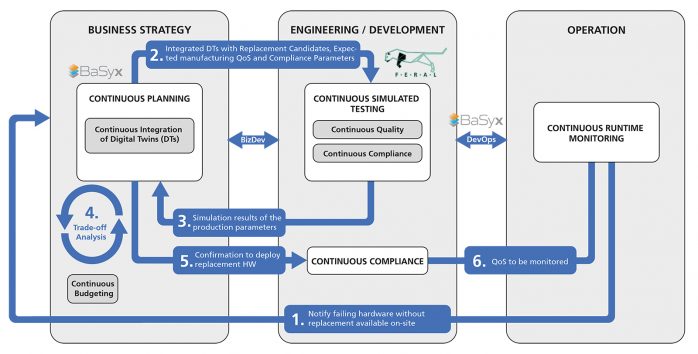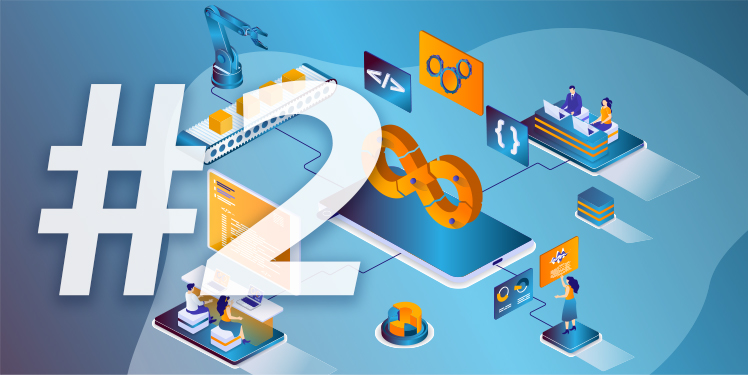Future-proof decision-making can be enabled by Continuous Planning and Continuous Budgeting with Continuous Integration of Digital Twins: Today we continue our series on Continuous Engineering for Industrie 4.0, where we explore how Continuous Engineering practices should be instantiated to the automation domain in order to support Industrie 4.0 principles. In this second post, we will explore how to consider Continuous Engineering practices for the Replacement of Machinery for Adequate Execution of Production in plants to implement Industrie 4.0 concepts, thereby enabling design-space exploration of replacement options.
Continuous Engineering for Industrie 4.0: Recap
The adoption of BizDevOps [1] practices has considerably smoothed the integration of Business Strategy, Engineering/Development, and Operation in the traditional software industry. In the Production Plant domain, there still exist challenges to overcome the strict separation of these aspects to increase performance and efficacy by means of continuous collaborations.
In this regard, in the first post of this series, we discussed Continuous Engineering practices to enable this for scenarios of rescheduling/reassignment of tasks to a redundant device due to hardware malfunction.
Replacement of Machinery for Adequate Execution of Production
In this post, we will discuss how Continuous Engineering practices should be considered to enable the replacement of machinery for adequate execution of production. This scenario assumes that (i) the production plant is operating, (ii) a production line or a cell is malfunctioning, has become completely unresponsive, or is not meeting the expected Quality of Services (hereafter QoS), and (iii) there are no redundancies available to replace the malfunctioning part. In this case, the company has to cautiously plan the acquisition of equipment to replace the faulty one, considering the long-term effect of the decision and the high costs associated with this. In this regard, both business and engineering must continuously collaborate to reach a decision that is technically, financially, and strategically adequate and thus future-proof.
Any equipment misbehavior is identified by the Continuous Runtime Monitoring (cf. Operations in Fig. 1) of the production plant. Such a misbehavior is, for example, a degradation of product quality or, in the extreme, a complete failure of the equipment itself. Upon the occurrence of hardware misbehavior/unresponsiveness, technical staff should perform onsite tests and minor maintenance at the operation site (e.g., restart, clean or change tools).

Figure 1. Replacement of Machinery for Adequate Execution of Production [2].
If the misbehavior persists, it is necessary to analyze the impact of the failing equipment on the overall production and plan the substitution of the failing equipment. In this scenario, this would mean buying a replacement. The acquisition of new machinery is a decision that implies an expenditure ranging from hundreds to hundreds of thousands of euros. In this regard, efficient and effective Continuous Planning (cf. Business Strategy in Fig. 1) will minimize the impact of such failures and mitigate the impact on the Business Strategy.
Continuous Production Planning based on Digital Twins
Common production planning activities consist of making decisions to keep the production operational and optimized according to specific operational (e.g., production/time unit or product quality) and business aspects (financial and time variables). In this regard, it is necessary to equip the staff with means to continuously, efficaciously, and efficiently perform production planning in order to deal with Industrie 4.0 dynamics such as the production of customized items of lot size 1. To this end, the use of Digital Twins plays a key role because multiple combinations can be continuously experimented with and evaluated using digital copies of physical artifacts (e.g., machines and resulting production pieces), logical artifacts (e.g., production schedules), and even humans involved in the production process, all this without having to stop the production.
In the case of the Replacement of Machinery for Adequate Execution of Production scenario discussed in this post, industries that have to replace a faulty piece of equipment can experiment with alternatives from different providers without necessarily having to interact with the physical equipment. Instead, the interaction takes place with the Digital Twins of the replacement candidates offered by the different manufactures. To realize this, it is necessary to have uniform means to represent Digital Twins that enable them to interact with each other. This uniform representation of Digital Twins is called Asset Administration Shell, and is offered by the Eclipse BaSyx platform.
Virtually Testing Replacement Options with Continuous Engineering
In the faulty equipment replacement scenario discussed here, the Digital Twins of the replacement candidates are integrated into the Digital Twin of the plant and evaluated with confidence by performing simulated testing to reveal the extent to which the plant with the newly integrated entity will meet the expected manufacturing QoS and comply with specific constraints, such as industrial policies. These capabilities of continuously integrating Digital Twins (Continuous Integration of Digital Twins (DTs) in Figure 2) and testing with confidence obtained from simulations whether the plant modified by the integration of a new piece of equipment will meet specific production expectations (Continuous Simulated Testing in Figure 2) are fundamental for improving the efficiency of selecting the replacement of a faulty equipment. We recommend performing Continuous Simulated Testing with the platform Fraunhofer FERAL, which offers capabilities to perform simulations at different levels of abstraction and also supports the coupling of different simulators.
Production Planning based on Digital Twins is also beneficial for speeding up multiple internal budgeting negotiations involved in this equipment replacement scenario. The acquisition of new machinery is a decision that implies an expenditure of budget ranging from hundreds to hundreds of thousands of euros and usually demands multiple interactions. This Continuous Budgeting practice is a key aspect to enable Industrie 4.0, especially because in this context, budgeting becomes a continuous activity (not an annual event) to deal with the finance aspects associated with the dynamics of Industrie 4.0 scenarios.
The interactions between Business Strategy and Engineering/Development (cf. Fig. 1) remain until an adequate replacement for the malfunctioning equipment is found. After the physical equipment replacement has been ordered and has arrived at the site, it is deployed and then Continuous Runtime Monitoring restarts to check whether the replacement equipment is working in production as expected. If a parameter is violated due to the rescheduling, the continuous cycle restarts.
This automated continuous cycle for dealing with the Replacement of Machinery for Adequate Execution of Production is made possible because of the orchestration performed by continuous engineering tools like GIT, Jenkins, Docker, the Industrie 4.0 middleware BaSyx [3], and the simulator FERAL[4]. The technical description, i.e., how this is implemented technically, will be presented in future articles of this blog series. So stay tuned!
For further information concerning the topic of „Continuous Engineering for
Industrie 4.0“, please check the following articles and videos:
[1] Tech Target, https://searchsoftwarequality.techtarget.com/definition/BizDevOps-Business-Development-and-Operations
[2] we extended the generic Continuous Engineering framework proposed by Fitzgerald and Stol in https://www.sciencedirect.com/science/article/abs/pii/S0164121215001430
[3] Eclipse BaSyx, https://www.eclipse.org/basyx/
[4] Fraunhofer IESE, https://www.iese.fraunhofer.de/en/services/virtual-architecture-development-and-evaluation.html

